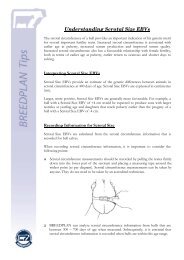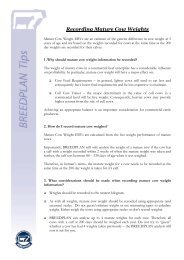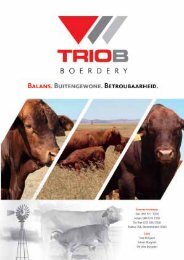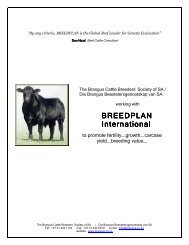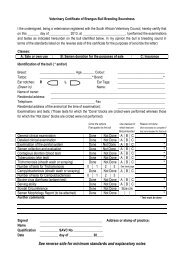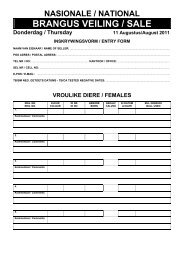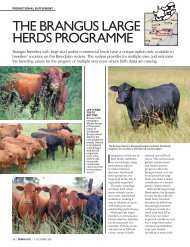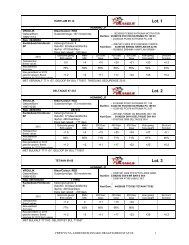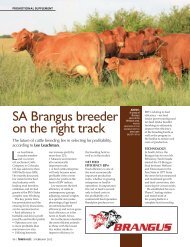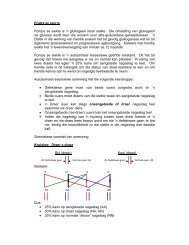Understanding Milk EBVs - Breedplan
Understanding Milk EBVs - Breedplan
Understanding Milk EBVs - Breedplan
Create successful ePaper yourself
Turn your PDF publications into a flip-book with our unique Google optimized e-Paper software.
<strong>Understanding</strong> <strong>Milk</strong> <strong>EBVs</strong>The weight of a calf at 200 days is influenced by many factors. Research has shown that70% of the variation between the weight of calves at 200 days can be attributed to nongeneticfactors (eg. nutrition, disease), 20% to differences between the calf’s genetics forgrowth and the remaining 10% to differences in the maternal contribution made by themother.The maternal contribution of the mother is consequently an important consideration forbeef enterprises. Differences in the contribution of the dam to the 200 day weight of thecalf are influenced by such things as the amount of milk the calf receives, the quality ofthe milk received and the mothering ability of the dam.Interpreting <strong>Milk</strong> <strong>EBVs</strong><strong>Milk</strong> <strong>EBVs</strong> provide an estimate of the maternal contribution of a dam to the 200 dayweight of her calf. In the case of sires, this estimates the maternal contribution that hisdaughters will make to the 200 day weight of their progeny.The <strong>Milk</strong> EBV is expressed in kilograms and indicate the expected difference in theweight of the calf at 200 days due to the maternal contribution of the cow.Larger, more positive, 200 Day <strong>Milk</strong> <strong>EBVs</strong> are generally more favourable, depending onthe environment. For example, a bull with a 200 Day <strong>Milk</strong> EBV of +15 kg would beexpected to sire daughters with higher milk production than a bull with 200 Day <strong>Milk</strong>EBV of +5 kg. This higher milk production potential should be reflected throughhigher weaning weights among the daughter's calves.It is important to note that the optimum level of <strong>Milk</strong> EBV will be dependent upon theproduction system and environment in which the cows are run. Selection for increasedmilk production may be warranted when cows are run under good nutritionalconditions and calves are sold as weaners. However, some environments may notsupport high milking cows. For example, high milking cows may not get back in calf aseasily as lower milking cows in the following year.How is the <strong>Milk</strong> EBV calculated?The <strong>Milk</strong> EBV is calculated by partitioning the difference in the 200 day weight ofcalves into growth and milk components. The following explanation provides asimplistic demonstration of how the BREEDPLAN analysis uses the 200 day weight ofa calf to calculate its <strong>Milk</strong> EBV.1. Initial Calculation of an EBVBefore the <strong>Milk</strong> EBV can be considered, it is necessary to outline the basic calculationof an EBV. In a simple situation, the calculation of an EBV is a very straight forwardprocess. The only information that is needed is the animal’s own performance, the
performance of its peers and the heritability of the trait (nb. heritability is defined as theproportion of the genetic superiority or inferiority of an animal that is passed on to itsprogeny).Once this information is available, the EBV can be defined as :EBV = (Animal’s Performance – Average Performance of Peers) x HeritabilityFor example, if a bull weighed say 60 kg above the average of its peers at 400 days, itsEBV would be calculated as follows:400 Day Weight EBV = 60 kg x 0.30= +9 kgsOf course, in real life the calculations become far more complicated. In a GROUPBREEDPLAN evaluation, the calculation of <strong>EBVs</strong> for an animal include : the animal’s own performance the performance of all known relatives in all herds the relationship between the different traits the performance of all herds over all years of recording2. Calculation of <strong>Milk</strong> EBVHaving looked at a simple EBV calculation, let’s consider the calculation of the <strong>Milk</strong>EBV. In this scenario, the calf has an adjusted 200 day weight of 300 kg compared tothe group average of 260 kg. That is, the calf is 40 kg heavier than the average weight ofhis peers.As stated previously, research has shown that 70% of the variation between the weightof calves at 200 days can be attributed to non-genetic factors (eg. nutrition, disease),20% to differences between the calf’s genetics for growth and the remaining 10% todifferences in the maternal contribution made by the mother. In technical terms, thismeans the heritability of the <strong>Milk</strong> EBV is 10% and the heritability of growth to 200 days(ie. 200 Day Growth EBV) is 20%.With all the required information known, the BREEDPLAN analysis can partition the40 kg superiority of the above calf into growth and milk components:<strong>Milk</strong> EBV= (Animal’s Performance – Performance of Peers) x Heritability= 40 kg x 0.1= +4 kg200 Day Growth EBV = (Animal’s Performance – Performance of Peers) x Heritability= 40 kg x 0.2= +8 kgIn contrast to the 200 Day Growth EBV, the extra weight of the calf due to milkreflects the cow’s genetic potential, so only half of the EBV is inherited by the calf.
Therefore, the cow’s <strong>Milk</strong> EBV will be +4 kg and the calf’s <strong>Milk</strong> EBV will be +2 kg.The calf’s 200 Day Growth EBV will remain at +8 kg.As stated previously, the calculations in the BREEDPLAN analysis become far morecomplicated than in this simplistic example. In a GROUP BREEDPLAN evaluation,the calculation of <strong>Milk</strong> <strong>EBVs</strong> for an animal can also be influenced by : the later weight performance of the animal the other calves from the dam of the calf the performance of all known relatives in all herdsThat is, there are literally thousands of calculations that go into producing an EBV forevery animal in a large performance recorded population. You can’t do thesecalculations “on the back of an envelope”.Recording Information for <strong>Milk</strong>As the <strong>Milk</strong> EBV is calculated by partitioning the difference in the 200 day weight ofcalves into growth and milk components, the live weight of calves at 200 days needs tobe recorded for the calculation of <strong>Milk</strong> <strong>EBVs</strong>.While most stud producers will be reasonably comfortable with how to record the liveweights of their animals, there are a number of important considerations that should bemade in order to maximise the effectiveness of the 200 day weights that are recorded.Weights should be recorded when animals are between 80 and 300 days of age.Weights should be recorded to the nearest kilogram.A management group should be entered for any calf or group of calves that haveeither been treated differently or exposed to significant non-genetic influences sincethe previous weighing. For example, calves given a supplement should be recordedin a different group to those without a supplement. Consideration should also begiven to variations in pasture quality, stocking rates, water quality, etc. Note thatblank is a unique management group.To ensure the maximum number of calves are analysed in the same managementgroup, you should try to weigh all the animals from one management group on thesame day. BREEDPLAN will automatically split your management groups if youweigh on different days.Ideally, calves should be weighed when they are in as large a group as possible.Consequently, try to weigh calves before any of the calves in the management groupare treated differently. For example, weigh before you castrate some of your bullcalves or before the show team is separated out from the rest of the group.BREEDPLAN can analyse up to two 200 day weights on each animal. Generallyspeaking, it is only necessary to record one weight, however in some circumstances,recording more than one 200 day weight may improve the accuracy of the <strong>EBVs</strong>.
In addition, breeders particularly looking to optimise the quality of the <strong>Milk</strong> <strong>EBVs</strong> thatare generated for their calves should also consider:The weights of calves should be recorded at or before weaning.If you are concerned that a significant number of cows are weaning calves naturallybefore the calves are “physically” weaned, then it may be beneficial to considertaking an early weight on all calves. That is, if you aren’t weaning calves until theyare 200 days of age but some cows start to “dry off” at 150 days of age, it mayimprove the accuracy of your <strong>Milk</strong> <strong>EBVs</strong> if you weigh all calves when they arearound 150 days of age.BREEDPLAN will also use the 400 day weight recorded for a calf as a repeatmeasure in the calculation of its <strong>Milk</strong> EBV. Therefore, recording 400 day weight willfurther enhance the accuracy of your <strong>Milk</strong> <strong>EBVs</strong>.Live weight information should be submitted directly to the BREEDPLAN office atABRI.The main method of submitting live weight information is by completing theBREEDPLAN “performance recording forms”. Performance recording forms will besent to you shortly after you record your calves with your Breed Society/Association orcan be requested by contacting staff at BREEDPLAN.Alternatively, live weight information can be submitted electronically via either: a BREEDPLAN compatible herd recording computer program the performance submission facility offered on some Breed Society/Associationwebsites the BREEDPLAN compatible Microsoft Excel template.For more information regarding <strong>Milk</strong> <strong>EBVs</strong>, please contact staff at BREEDPLAN.



